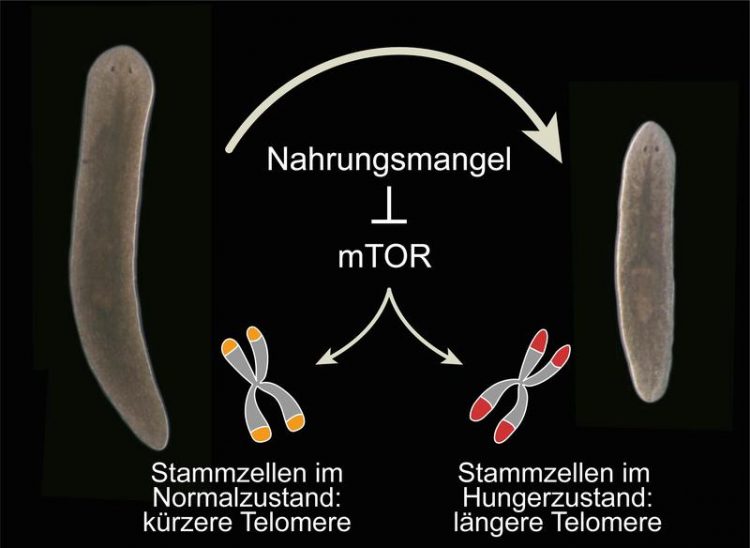Immortal Planarians: Better Stem Cells under Starvation

Starvation has a positive effect on the adult stem cell pool in Planarians; under starvation stem cells show longer telomeres [Source: FLI / Magdalena Voll]
Planarians are very plastic animals. They are able to regenerate whole body parts; even from a tiny fragment of their body, they are able to regenerate a new individual. This amazing regeneration ability is due to their somatic stem cell pool, which is able to infinitely replace old or damaged cells.
As in their natural surrounding periods of food scarcity occur, they developed astonish survival strategies under starvation: they can shrink in size and then regrow if they get food again always maintaining their stem cell pool. Because of the astonishing plasticity, they are used as model organism for example in aging research.
A research team around Dr. Cristina González-Estévez of the Leibniz Institute on Aging – Fritz Lipmann Institute (FLI) in Jena, Germany and the Spanish National Center for Cardiovascular Research in Madrid, Spain now investigated the development of the planarian stem cell pool under conditions of starvation.
“The central question is how starvation regulates somatic stem cells”, tells González-Estévez about the motivation behind the study. It was already known that starvation has a positive impact on stem cells, but the underlying molecular mechanisms remained unclear. Planarians with their astonishing regeneration capacity due to the high number of stem cells are therefore a good model organism to address this question.
Longer Telomeres in Planarian Stem Cells
Telomeres are repetitive sequences at each end of a chromosome that protect them from deterioration and fusing with other chromosomes.
Over time, during each cell division, these telomeres become shorter. This shortening has been shown to be associated with aging and aging-related diseases in different organisms such as mice and humans. The international research team now investigated stem cells and their telomere length in planarians.
“Our results show that long telomeres are a major characteristic of adult stem cells in planarians”, says González-Estévez.
The researchers used the method TelQ-FISH (telomere quantitative fluorescence in situ hybridization) to measure stem cells telomere length of planarians under starvation. “This method has usually been used in mice but we adopted it to planarians for the very first time”, says González-Estévez.
“We were able to show that under starvation the quality of the stem cell pool in planarians is improved due to a higher telomere length.”
Special Mechanisms during Starvation
The researchers found that starvation leads to an enrichment of stem cells with the longest telomeres. This enrichment is dependent on mTOR signaling, which is downregulated during starvation. mTOR is an important sensor pathway that controls cell growth and proliferation, also in humans.
The results show that starvation increases the proportion of stem cells with longer telomeres through inhibition of mTOR signaling. On the other hand, mTOR up-regulation abolishes the effect of starvation on the telomere length of the stem cells. This suggests that starvation has a rejuvenating effect on planarian stem cells.
But what mechanisms are behind this? The researchers have two different hypothesis explaining the result: It might be the case that during starvation those stem cells with longer telomeres tend towards symmetric divisions forming two new stem cells. Another possibility would be that stem cells with long telomeres increase self-renewal when mTOR signaling is down whereas those with short telomeres die or differentiate.
The results of this study underline the positive effect of fasting on the adult stem cell pool and telomere length, which is associated with longevity. Further studies based on the experimental methods refined in this study should reveal whether the relation between the mTOR pathway on stem cells and telomere length could be also shown in other model organisms or even humans.
Publication
Marta Iglesias, Daniel A. Felix, Óscar Gutiérrez-Gutiérrez, Maria del Mar De Miguel-Bonet, Sounak Sahu, Beatriz Fernández-Varas, Rosario Perona, A. Aziz Aboobaker, Ignacio Flores, Cristina González-Estévez. Down-regulation of mTOR signaling increases stem cell population telomere length during starvation of immortal planarians. Stem Cell Reports. 2019. DOI: https://doi.org/10.1016/j.stemcr.2019.06.005
Contact
Magdalena Voll
Press and Public Relations
Phone: 03641-656373, Email: presse@leibniz-fli.de
Magdalena Voll
Marta Iglesias, Daniel A. Felix, Óscar Gutiérrez-Gutiérrez, Maria del Mar De Miguel-Bonet, Sounak Sahu, Beatriz Fernández-Varas, Rosario Perona, A. Aziz Aboobaker, Ignacio Flores, Cristina González-Estévez. Down-regulation of mTOR signaling increases stem cell population telomere length during starvation of immortal planarians. Stem Cell Reports. 2019. DOI: https://doi.org/10.1016/j.stemcr.2019.06.005
http://www.leibniz-fli.de – Website Leibniz Institute on Aging – Fritz Lipmann Institute (FLI) Jena
Media Contact
All latest news from the category: Life Sciences and Chemistry
Articles and reports from the Life Sciences and chemistry area deal with applied and basic research into modern biology, chemistry and human medicine.
Valuable information can be found on a range of life sciences fields including bacteriology, biochemistry, bionics, bioinformatics, biophysics, biotechnology, genetics, geobotany, human biology, marine biology, microbiology, molecular biology, cellular biology, zoology, bioinorganic chemistry, microchemistry and environmental chemistry.
Newest articles

NASA: Mystery of life’s handedness deepens
The mystery of why life uses molecules with specific orientations has deepened with a NASA-funded discovery that RNA — a key molecule thought to have potentially held the instructions for…

What are the effects of historic lithium mining on water quality?
Study reveals low levels of common contaminants but high levels of other elements in waters associated with an abandoned lithium mine. Lithium ore and mining waste from a historic lithium…

Quantum-inspired design boosts efficiency of heat-to-electricity conversion
Rice engineers take unconventional route to improving thermophotovoltaic systems. Researchers at Rice University have found a new way to improve a key element of thermophotovoltaic (TPV) systems, which convert heat…



